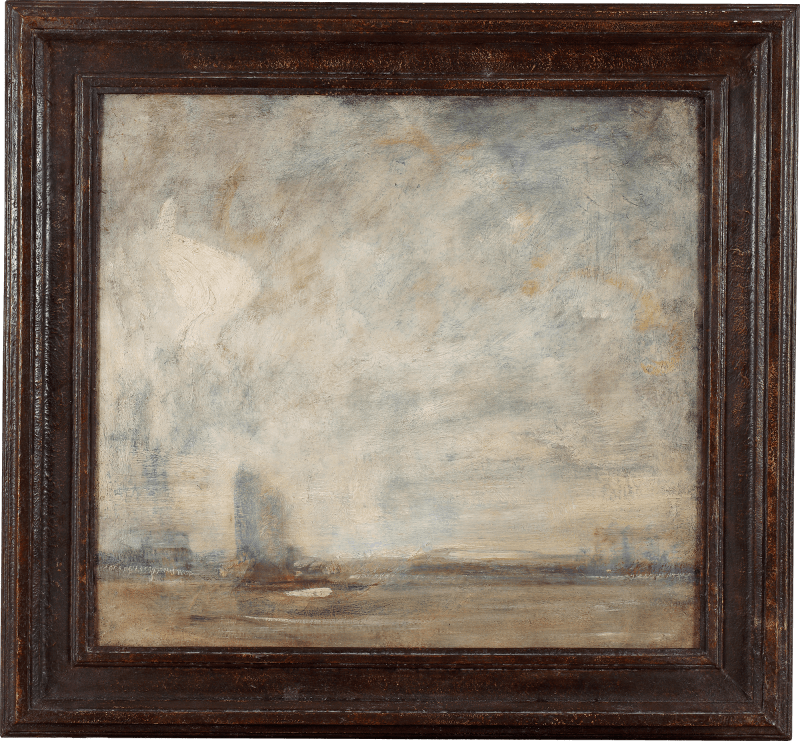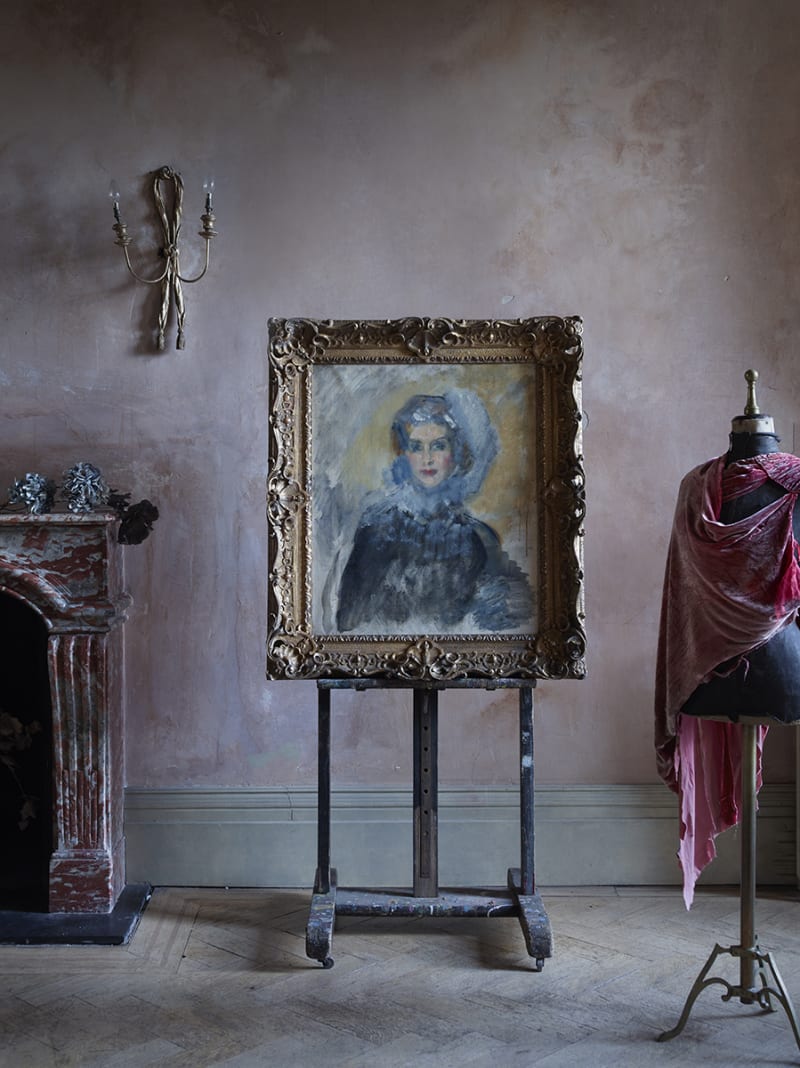Enquire
To view all current artworks for sale visit philipmould.com
The present portrait – a dynamic example of McEvoy’s post-impressionist technique - is almost certainly a product of Saturday afternoon sittings between 1917 and 1919, when Daphne Baring was encouraged by her mother to have her portrait painted by Ambrose McEvoy. Sitting to McEvoy was a life-changing experience for Daphne, inspiring her to become an artist.
In her privately published memoirs, Daphne Pollen (née Baring) describes watching a furiously productive McEvoy, sitting on a slanted chair with two sawn off legs, consuming 20 to 30 paintbrushes per sitting and projecting an endearing personality. The final commission – for which this appears to be a preliminary work – was completed at McEvoy’s studio at 107 Grosvenor Road, Pimlico, and depicts Daphne seated and holding a strand of her hair. It is now in a private collection and was described by Rothenstein as ‘one of the best portraits [McEvoy] ever painted’....
The present portrait – a dynamic example of McEvoy’s post-impressionist technique - is almost certainly a product of Saturday afternoon sittings between 1917 and 1919, when Daphne Baring was encouraged by her mother to have her portrait painted by Ambrose McEvoy. Sitting to McEvoy was a life-changing experience for Daphne, inspiring her to become an artist.
In her privately published memoirs, Daphne Pollen (née Baring) describes watching a furiously productive McEvoy, sitting on a slanted chair with two sawn off legs, consuming 20 to 30 paintbrushes per sitting and projecting an endearing personality. The final commission – for which this appears to be a preliminary work – was completed at McEvoy’s studio at 107 Grosvenor Road, Pimlico, and depicts Daphne seated and holding a strand of her hair. It is now in a private collection and was described by Rothenstein as ‘one of the best portraits [McEvoy] ever painted’....
To view all current artworks for sale visit philipmould.com The present portrait – a dynamic example of McEvoy’s post-impressionist technique - is almost certainly a product of Saturday afternoon sittings between 1917 and 1919, when Daphne Baring was encouraged by her mother to have her portrait painted by Ambrose McEvoy. Sitting to McEvoy was a life-changing experience for Daphne, inspiring her to become an artist. In her privately published memoirs, Daphne Pollen (née Baring) describes watching a furiously productive McEvoy, sitting on a slanted chair with two sawn off legs, consuming 20 to 30 paintbrushes per sitting and projecting an endearing personality. The final commission – for which this appears to be a preliminary work – was completed at McEvoy’s studio at 107 Grosvenor Road, Pimlico, and depicts Daphne seated and holding a strand of her hair. It is now in a private collection and was described by Rothenstein as ‘one of the best portraits [McEvoy] ever painted’. This work, which remained with the artist and was passed on to his descendants, was probably not designed for public display or consumption, and is a window into the artist’s radical and intuitive freedom of technique in its thrilling use of primary colours and alla prima brushstrokes, foreshadowing expressionist painting of the next generation. Daphne Pollen recalls that McEvoy began his final composition with a blue monochrome basecoat, a colouring that stretches across the whole of the present canvas. Although hurried in its execution, McEvoy has captured Daphne Baring’s likeness with the same skill and sensitivity that he demonstrates in his final portrait, making it a standalone portrait as well as a possible compositional study. McEvoy had completed a full-length portrait of the sitter’s mother the previous year in 1916 which had defined the artist’s reputation as a fashionable society portraitist. Maude Louise Baring (née Lorillard) was the daughter of an American tobacco magnate, who married Cecil Baring, of Baring Brothers bank, in 1902. The year that their daughter Daphne was born the Barings bought Lambay Island just off the coast of Dublin, having been attracted to the unusual variety of flora and fauna. Their friend Edwin Lutyens quickly commenced transforming Lambay Castle into a home for the family. Whilst sitting to McEvoy between 1917 and 1919, Daphne pseudonymously exhibited her first ‘à la McEvoy’ painting of her sister Calypso at the Grosvenor Gallery and at fourteen years old she enrolled at the Slade School of Fine Art, where McEvoy had trained twenty-five years before. She went on to exhibit at the New English Art Club and the Redfern Gallery with several works throughout the 1920s and in 1926 she married the sculptor Arthur Pollen, who had also studied at the Slade under Henry Tonks. During the mid-1920s she illustrated two novels by her uncle Maurice Baring, A Triangle (1923) and Cat’s Cradle (1925) and in 1932 she drew a portrait of the writer Hillaire Belloc, now in the National Portrait Gallery collection. Daphne Pollen’s most famous surviving work is a group portrait titled The Forty English Martyrs (1968), commissioned by the General Postulation. Ambrose McEvoy showed artistic talent from a young age. He was encouraged by his father, Captain Charles Ambrose McEvoy, and his father’s friend James Abbott McNeill Whistler to pursue art and he enrolled at the Slade School of Fine Art at the age of fifteen, studying under Frederick Brown. McEvoy made close friends at the Slade including Augustus John, with whom he shared a studio for a time, and embarked on a ‘stormy’ affair with his sister, Gwen. In 1900 Gwen John was deeply hurt at McEvoy’s announcement that he was engaged to Mary Augusta Spencer Edwards, a fellow Slade student. Ambrose McEvoy and Mary Spencer Edwards married in 1902 and in 1906 they moved to 107 Grosvenor Road where they would spend the rest of their lives. McEvoy’s style of painting became looser and less controlled following his visit to Dieppe with Walter Sickert in 1909. His career, like so many artists, was interrupted by the First World War and in 1916 he was attached to the Royal Naval division and spent three months on the front line producing portraits of naval officers, many of which are now in the collection of the Imperial War Museum. At the height of McEvoy’s career he was painting twenty-five oil paintings a year, including sitters such as the Duchess of Marlborough, Claude Johnson chairman of Rolls Royce, Lady Diana Cooper and the actress Lillah McCarthy. In 1924 McEvoy became an associate of the Royal Academy and also a member of the Royal Society of Portrait Painters. Overwork took its toll and he died three years later in 1927. Few works of this quality by McEvoy have been on the market in recent years. A portrait described as an unknown lady, purchased by this gallery, sold at Dreweatt Neate February 2015 (£41,216) and was resold into the London art trade. It was of notably smaller dimensions (30 x 25 inches). D. Pollen, I Remember I Remember, (Privately published, 2008), p.158; McEvoy often used brown or green as a basecoat. J. Rothenstein, Modern English Painters, Sickert to Smith, (London, 1952), p.210. D. Pollen, I Remember I Remember, (Privately published, 2008), p.156. D. Pollen, I Remember I Remember, (Privately published, 2008), pp. 7 & 170; Oxford Dictionary of National Biography online, ‘McEvoy, (Arthur) Ambrose)’. D. Buckman, Artists in Britain Since 1945, volume 2, (Bristol, 2006), p.104. Captain McEvoy became friendly with Whistler as he fought alongside one of Whistler’s brothers in the Confederate army during the American Civil War. |








